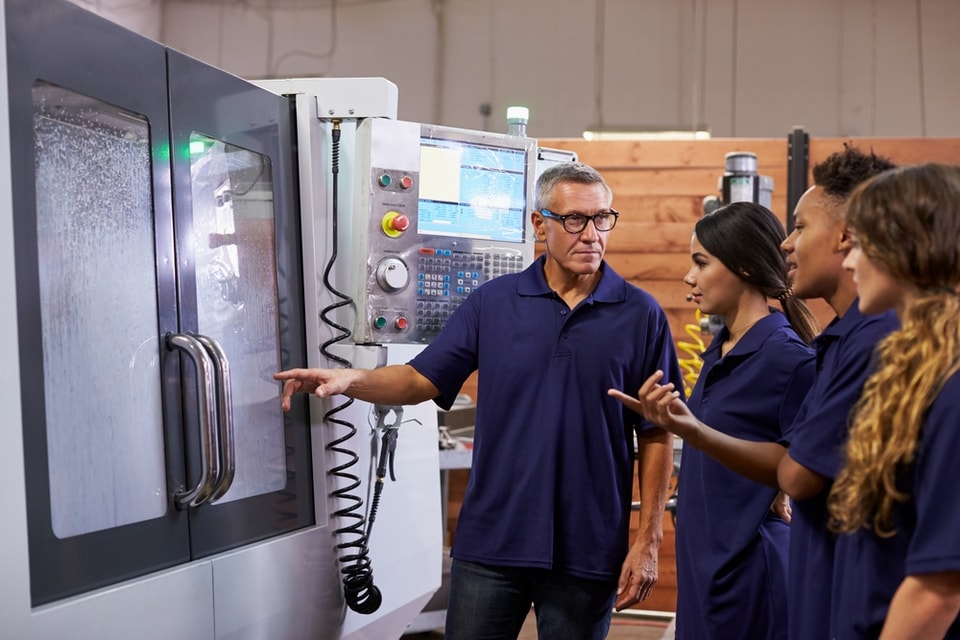Memo Published May 26, 2021 · 13 minute read
What’s next for the Workforce Innovation and Opportunity Act?
Kelsey Berkowitz & Sergio Galeano

Takeaways
As the country emerges from the COVID pandemic, many workers will need to navigate a vastly different jobs landscape. To succeed in this new era, many will need to learn new skills, upgrade their old ones, develop new professional networks, and get connected to new employers and opportunities. Congress can help workers do this by improving the Workforce Innovation and Opportunity Act (WIOA), the law that authorizes the nation’s workforce development system. In this paper, we propose three ways to reform WIOA to dramatically expand its impact and help more workers in a post-COVID era:
1. Significantly expand employer-based training.
2. Guarantee universal access to career services.
3. Guarantee universal access to supportive services.
Now that the American Rescue Plan has become law and is churning out essential support, policymakers are turning to a new question—what does the country need for a long-term economic recovery? That answer is affected by a jobs landscape that looks very different than the one that existed before the pandemic. Some industries, like e-commerce, have grown while the pandemic has severely impacted others, like leisure and hospitality. Overall, job displacement during the pandemic will force over 17 million Americans to find new occupations.1 Moreover, structural changes to the economy and a growing need for apprenticeships and postsecondary credentials, along with traditional two- and four-year degrees, will require a robust workforce training system.
The American Jobs Plan and American Families Plan will greatly help workers. But let’s not stop there. Policymakers have another tool they should modernize this year: the Workforce Innovation and Opportunity Act (WIOA). WIOA is the federal government’s primary legislative vehicle for workforce development programs and initiatives. It authorizes funding for job training and for the nation’s network of American Job Centers (AJCs)—physical locations where jobseekers can go to access a range of job search services, including career counseling and access to job training programs.
Passed in 2014 by a wide bipartisan majority, WIOA was the first major investment in the country’s workforce development system since the passing of its predecessor, the 1998 Workforce Investment Act (WIA). Beyond the need for reauthorization, WIOA aimed to increase coordination across the workforce system’s core programs and better align national workforce strategy. Among the reform’s goals were improved coordination of workforce efforts within states, improved accountability and performance measurements, greater support for the AJC system, expanded services for employer based training, and key investments in historically vulnerable populations.
However, there remain persistent gaps between WIOA’s intended goals and its implementation. Even more challenging, federal funding for workforce development programs has decreased by more than 40% over the past two decades, leaving state programs underfunded and unable to meet worker demand for services and job-related assistance.2 Given these underlying conditions, and amidst the current economic fallout from the pandemic and long-standing labor trends that are ushering in deep structural changes to the American economy, WIOA needs reforms.
As Congress considers reauthorization of WIOA, lawmakers have an opportunity to greatly expand and strengthen our workforce development system so that it contributes to our economic recovery, enables displaced workers to access quality jobs and regain their footing in the labor market, and ensures all workers can succeed in the future of work. Below are recommendations for how Congress can make this a reality. Specifically, we need a workforce development system that 1. enables small and mid-sized employers to play a larger role in talent development, 2. offers career services to every American, and 3. ensures people have the assistance they need to successfully complete workforce development programs.
1. Significantly expand employer-based training.
Employer-provided training can be a vital tool to help workers learn new skills and evolve within their company or industry. For example, retail workers may need training to move into new roles improving customers’ online shopping experiences. Workers in food industry occupations may need training to learn how to work alongside robots, troubleshoot them, or move into management roles. And solar panel installers will need training and certification to perform effectively in one of the fastest growing occupations of the decade.
Unfortunately, we don’t do nearly enough to support this kind of training in the United States. Currently, under WIOA, local workforce boards can only spend up to 20% of their Adult and Dislocated Worker funds on “incumbent worker” training (put another way, their current employees). Additionally, National Skills Coalition research finds that only 30 states have their own dedicated funding for incumbent worker training, and after funding declines in recent years, these programs often only cover a small share of workers who could benefit from them. On top of that, small- and mid-sized employers often lack the internal capacity to build these programs on their own.
The federal government must do more to encourage employers to provide training and support them in doing so. Here’s how:
Create a 21st Century Training Fund. Congress should make a major, long-term investment to help every state in the nation have a robust employer-provided training program. Specifically, Congress should create a new source of dedicated funding for employer-provided training within the US Department of Labor so states can plan and make long-term commitments. National Skills Coalition has similarly recommended creating a new Federal Incumbent Worker Training Fund, which would provide states with formula funds as a new title under WIOA. States would use these dedicated resources to fund training partnerships, help existing workers advance within a company, or ensure new hires can gain skills needed to succeed in their new industry.
Give states flexibility on how they use funding. States should be given flexibility in how they use these funds. For example, some states may want to use their funds to create their own versions of California’s Employment Training Panel, which reimburses employers that invest in approved training. Other states may want to use their funds to help small businesses identify and partner with training providers or band together to establish joint training programs. Regardless of how states decide to structure their programs, they should prioritize partnering with small and midsized businesses who have less ability to provide or coordinate training on their own. States should also ensure these training opportunities lead to high-quality jobs and are available to workers in lower-paid positions, workers with lower levels of formal education, workers of color, people with disabilities, and others who have traditionally been left out of employer-provided training.
Help states create high-quality programs. States may need guidance on how best to maximize their federal allocations—particularly if they are building a program from scratch. Congress should direct the US Department of Labor to scan existing state incumbent worker training programs, identify best practices, and provide technical assistance to help states create or expand their programs. The Bureau of Labor Statistics should regularly collect and share data on employer-based training to support evaluation of these programs and build a deeper understanding of what works.
Lift WIOA’s incumbent worker training cap. As an alternative, Congress should consider lifting WIOA’s cap on incumbent worker training. Congress should also give local boards greater flexibility to provide technical assistance and training support to employers, particularly small and midsized employers or employers engaged in sector partnerships. Even with the cap lifted, however, we will need to invest significant new funding to make employer-provided training a robust part of our workforce development system.
Better leverage the tax code to support training. Another proposal to spur more employer-provided training is the Aspen Institute’s idea to create a Worker Training Tax Credit, structured similarly to the R&D tax credit. This idea, which is similar to the R&D tax credit, would promote employer-sponsored training for low- and middle-skill workers. The tax credit would offset 20% of the cost of offering new training activities, like employer-provided training that leads to an industry-recognized credential. To ensure employers target low- and middle-skill workers, the tax credit would only cover training for workers who earn less than $120,000 a year.
Create dedicated funding for sector partnerships. Although WIOA includes provisions requiring local workforce development boards to establish sector partnerships, it lacks a dedicated funding stream to finance their creation and implementation.3 Sector programs serve as platforms that help coordinate workforce efforts across employers, identify growing industries, and help support and train workers for in-demand, high-wage jobs, matching worker demand with local needs. These programs have been shown to increase education, through training and credential programs, and living standards, through higher-wage jobs.4
2. Guarantee universal access to career services.
Over two decades ago, the federal government created American Job Centers—offices throughout the country intended to be a one-stop-shop that provide crucial services to jobseekers, from job search assistance and career counseling to referrals to job training programs. Nearly 2,400 AJCs exist across the United States, and together they’ve provided services to nearly 15.6 million Americans from mid-2019 to mid-2020, from self-service in the resource rooms to career counseling and training.5
The problem is that AJC services aren’t available to enough Americans. As WIOA funding has eroded over time, AJCs have received less resources to deliver help to those who need it. Take, for example, one-on-one career counseling and development of individual employment plans. Credential Engine recently found that there are nearly 1 million unique credentials for learners to choose from—a figure that has grown each year since Credential Engine began counting. Sorting through those options is a daunting task for anyone. That’s why it’s critical to have career counselors in AJCs who can provide tailored guidance to help people identify the career paths, skills, training programs, and credentials that are right for them given their career aspirations. But over the last program year, only about 44% of Adult, Dislocated Worker, and Wagner-Peyser participants received individualized career services, or just 1.8 million Americans.6
Congress can do more to invest in American Job Centers, transforming them into career centers for all Americans. Services should be available to people who are out of work as well as those who want to upgrade their skills to keep up with the changing demands of their job and those who want to change industries entirely. Here’s how:
Provide flexible funding to expand and modernize AJC services. Congress should inject a significant amount of new funding into the WIOA system and should require this funding to go towards making AJCs more accessible and increasing the capacity of AJCs to deliver services to more Americans. For example, lawmakers could specify that these funds can be used to expand one-on-one career counseling, offer digital skills training, provide child care and transportation for jobseekers, partner with other community centers (e.g. libraries), and more.
New funding should also allow AJCs to modernize their operations, provide virtual services, and expand their reach. Before the pandemic, jobseekers often had to physically visit AJCs to access services, costing workers time and money across both rural and urban regions. As a result of the pandemic, many AJCs have pivoted to delivering services virtually. A boost in funding would allow AJCs to strengthen and expand these changes so they become a permanent part of how AJCs operate.
3. Guarantee universal access to supportive services.
Too many people in job training programs struggle to afford necessities. Time and financial constraints may hinder them from enrolling in training altogether, even if doing so would allow them to enter higher-paying careers. For example, a person may not be able to find child care while in training, may not have a car or be able to afford to commute to a training program, or may not be able to make rent if they invest in new skills. On the flip side, research has found that single mothers who receive child care subsidies are more likely to enroll in education and job training programs.7
A recent IWPR report confirms that financial difficulties, inability to afford necessities like transportation and child care, and problems with work hours and scheduling are major barriers to completion of job training programs. Expanding earn-and-learn training options, such as apprenticeships, can help with this, as these options allow people to earn a paycheck while they complete their training. Not all job training is delivered this way, however, and far too many people are struggling to complete programs without access to supportive services.
The federal government should ensure that anyone in a training program has access to supportive services in order to complete their education. Here’s how:
Create Supportive Services Formula Grants Within WIOA. Congress should provide dedicated funding to state and local workforce boards to increase access to supportive services for people in training programs. Lawmakers could give boards a range of options for how to use this funding, including:
- Providing supportive services directly to workers;
- Paying job training providers to provide services directly;
- Creating or strengthening partnerships between stakeholders in the job training system and supportive service providers to enable more referrals;
- Helping training providers better understand what resources are already available and improve coordination and referrals; and
- Working with partner organizations to develop supportive services where they are currently lacking.
Congress should consider distributing funds to each state via a formula based on factors like the share of the state’s population living below the poverty line. In devising formulas to distribute funding under WIOA, policymakers should be mindful that formulas that distribute funds based on population could end up penalizing rural areas, despite the unique set of challenges local officials and administrators face in delivering workforce development services to rural communities. Finally, in distributing funding to training providers, workforce boards should be encouraged to provide funding to those with smaller budgets.
Create Trainee Success Stipends. Lawmakers could also make stipends available to people enrolled in eligible training programs. Recipients could receive their stipend in the form of a pre-paid debit card that can only be used for eligible expenses, similar to flexible spending accounts. Stipend amounts could be dependent on the mix of supportive services each trainee needs and could be discussed ahead of time with case managers at American Job Centers. For example, a trainee who only needs help paying rent while in training may need a smaller stipend than a trainee who also needs help with transportation and child care.
Injecting more supportive service funding into the workforce development system should not preclude us from the long-term task of building a comprehensive and robust child care system, transportation network, and safety net.
Conclusion
This pandemic has disrupted our economy and devastated millions of workers and their families. We will need a multi-pronged, comprehensive policy response to foster an inclusive economic recovery. We can ensure workforce development is a part of this by reforming and improving the Workforce Innovation and Opportunity Act. Through WIOA reauthorization, lawmakers have an opportunity to reshape our workforce development system so it centers the needs of workers and ensures employers play a role in skill development. Scaling up employer-provided training, expanding career navigation and other jobseeker services, and ensuring access to supportive services while people are in training will allow workers to succeed in the post-pandemic labor market.
Kelsey Berkowitz is a former senior policy advisor with Third Way’s Economic Program. She contributed to this report only during her tenure at Third Way.

